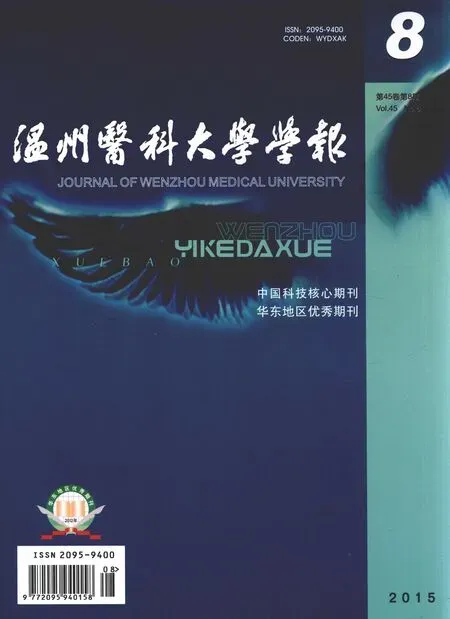同型半胱氨酸、叶酸和尿酸在认知功能障碍诊断中的意义
吴甜莺,张雄,郑永克,王一栋,潘静,陈艳
(1.温州市中心医院 干部科,浙江 温州 325000;2.温州医科大学附属第二医院 神经内科,浙江温州 325027)
·临 床 经 验·
同型半胱氨酸、叶酸和尿酸在认知功能障碍诊断中的意义
吴甜莺1,张雄2,郑永克1,王一栋1,潘静1,陈艳1
(1.温州市中心医院 干部科,浙江 温州 325000;2.温州医科大学附属第二医院 神经内科,浙江温州 325027)
目的:探讨检测同型半胱氨酸、叶酸和尿酸在认知功能障碍诊断中的意义。方法:选取阿尔茨海默病(AD)患者63例(AD组),血管性痴呆(VaD)患者56例(VaD组),轻度认知功能障碍(MCI)患者40例(MCI组),同时选取同期健康老年人45例为对照组,分别检测各组血浆中同型半胱氨酸、叶酸和尿酸水平。结果:①AD组和VaD组同型半胱氨酸水平均高于MCI组和对照组;②AD组、VaD组、MCI组3组叶酸水平均低于对照组,AD组、VaD组叶酸水平高于MCI组;③AD组尿酸水平低于VaD组、MCI组和对照组。结论:高水平的同型半胱氨酸可能参与了认知功能障碍的发展。较低水平的叶酸与认知功能障碍有关,AD患者具有较低的血浆尿酸水平。同型半胱氨酸、叶酸、尿酸水平可能与AD、VaD、MCI的发生发展有关,同型半胱氨酸、叶酸、尿酸水平的联合测定有助于认知功能障碍的诊断。
同型半胱氨酸;叶酸;尿酸;阿尔茨海默病;血管性痴呆;轻度认知功能障碍
目前我国已进入人口快速老龄化阶段,痴呆的患病率近年来呈明显增加的趋势[1]。阿尔茨海默病(Alzheimer’s disease,AD)和血管性痴呆(vascular dementia,VaD)是痴呆患者中最常见的两种类型,轻度认知功能障碍(mild cognitive impairment,MCI)是正常脑老化和痴呆间的一种认知功能损害。如何早期临床诊断痴呆并区分类型尚缺乏明确的指标,本研究拟通过回顾性分析比较AD、VaD、MCI患者与正常人血浆中同型半胱氨酸、叶酸和尿酸水平的区别,探讨这些指标对认知功能障碍诊断的意义。
1 临床资料
1.1 一般资料 选取2010年4月至2014年4月温州市中心医院干部科和温州医科大学附属第二医院神经内科收治的认知功能障碍患者,其中AD患者63例,男29例,女34例,年龄55~87岁;VaD患者56例,男24例,女32例,年龄60~87岁,MCI患者40例,男16例,女24例,年龄54~82岁。AD组的入组符合美国国立神经病语言障碍卒中研究所和AD及相关疾病协会(NINCDS-ADRDA)2007版诊断“很可能AD”的标准[2],VaD组的入组符合美国国立神经病和卒中研究所、瑞士神经科学国际学会(NINDS-AIREN)标准[3],MCI组的入组符合国际MCI工作组2004年诊断标准[4]。3组均排除有意识障碍、癫痫、失语、恶性肿瘤、严重营养不良及认知功能障碍发生在谵妄期的患者。同时选取温州市中心医院体检中心同期健康老年人45例为对照组,其中男21例,女24例,年龄64~81岁。纳入标准:年龄≥60岁,无严重躯体疾病,在认知功能、生活能力及社交能力等方面检查无异常。各组均以女性占多数,各组间年龄方面差异无统计学意义(均P>0.05),AD组、VaD组、MCI组3组受教育年限均比对照组低,差异有统计学意义(均P<0.05)。AD组和VaD组MMSE评分得分较低,MCI组较AD组得分高,差异有统计学意义(均P<0.05),见表1。
表1 各组间一般资料比较()

表1 各组间一般资料比较()
注:MMSE评分:简易精神状态评价量表,最高得分为30分,27~30分为正常,<27分为认知功能障碍。与对照组比:aP<0.05;与AD组比:bP<0.05
组别例数年龄(岁)女性比例(%)受教育年限(年)MMSE评分(分)AD组6374.52±9.0153.975.10±0.45a20.20±0.16aVaD组5678.45±8.0657.145.31±0.50a22.35±0.62aMCI组4072.04±8.3560.005.74±0.48a25.28±0.35b对照组4573.64±2.6553.337.21±0.15a27.24±0.57a
1.2 方法 ①同型半胱氨酸、尿酸的测定:所有受试对象均采集空腹晨血4 mL,应用美国DADE Behring公司全自动生化分析仪测定血浆同型半胱氨酸及尿酸水平;②叶酸的测定:所有受试者均采集空腹晨血3 mL,应用微粒子酶免分析法测定血浆叶酸浓度。
1.3 统计学处理方法 采用SPSS 16.0统计软件处理。计量资料以表示,两两间比较采用t检验,多组间比较采用单因素方差分析。P<0.05为差异有统计学意义。
1.4 结果 AD组和VaD组同型半胱氨酸水平均高于MCI组和对照组,差异有统计学意义(均P<0.05);AD、VaD、MCI 3组叶酸水平均低于对照组,AD、VaD组叶酸水平高于MCI组,差异有统计学意义(均P<0.05);AD组尿酸水平低于VaD组、MCI组和对照组,差异有统计学意义(P<0.05),见表2。
2 讨论
认知功能障碍(包括AD、VaD、MCI等)是多种因素作用下的脑功能衰退,其具体的病因仍不十分明确,已有一定数量的证据表明高同型半胱氨酸血症与认知功能障碍存在密切的联系[5-7]。高同型半胱氨酸血症影响认知功能障碍的可能机制如下:①高同型半胱氨酸血症是脑血管疾病的一个独立风险因子[8],可参与动脉粥样硬化、血栓的形成,使脑卒中的危险性增加[9],从而易导致VaD,也易引起大脑皮质低灌注,加重脑萎缩,从而诱发AD;②导致内皮素功能异常,降低一氧化氮活性,从而加速氧化应激,加速脑老化;③诱导海马神经元凋亡,加重Aβ生成,促进AD的发生。有研究显示,AD患者血浆同型半胱氨酸水平与MMSE评分呈显著负相关,表明高同型半胱氨酸血症可加剧认知功能障碍[10]。亦有研究[11]表明,AD患者血浆同型半胱氨酸水平显著高于健康对照者,与本研究结果相符。血浆同型半胱氨酸水平与VaD的发生也可能有着密切的关系,并可反映VaD患者的严重程度[12-13]。本研究结果提示,血浆高水平的同型半胱氨酸可能参与了认知功能障碍的发展,但在轻度认知功能障碍阶段尚未表现出差异。
表2 各组间血浆同型半胱氨酸、叶酸、尿酸水平比较()

表2 各组间血浆同型半胱氨酸、叶酸、尿酸水平比较()
与对照组比:aP<0.05;与MCI组比:bP<0.05;与VaD组比:cP<0.05
组别n同型半胱氨酸(μmol/L)叶酸(μg/L)尿酸(μmol/L)AD组6318.79±1.72ab7.32±1.75ab1 272.67±79.35abcVaD组5619.12±2.23ab7.63±2.06ab1 363.32±10.57abcMCI组4014.37±1.14ab14.45±4.93a1c337.89±10.85abc对照组4514.64±2.65ab23.75±10.62cc342.84±83.13abc
低血浆叶酸水平可能会增加AD的风险[14-15],与本研究结果相符。叶酸的缺乏与认知功能障碍密切相关,其机制可能与导致高同型半胱氨酸血症有关[16]。叶酸是同型半胱氨酸代谢过程中的重要甲基供体,人体内叶酸的缺乏可导致高同型半胱氨酸血症,从而可能与AD、VaD和MCI的发生有密切关系[17-19]。本研究提示,较低水平的叶酸与认知功能障碍有关,叶酸或许可作为MCI诊断的生化指标。高叶酸水平的膳食摄入或有助于降低卒中风险,但能否通过饮食摄入高水平的叶酸来达到预防痴呆仍需进一步的研究[20]。
尿酸是人体内一种水溶性抗氧化剂,在一定范围内具有清除自由基的作用。目前已发现高尿酸血症与代谢综合征密切相关[21],同时也是动脉粥样硬化和心血管病病死率的独立风险因子[22]。AD患者的血浆尿酸水平与正常人比较可能存在下降的趋势[23-26]。尿酸在AD患者中的作用机制仍未明确,其可能通过抗氧化应激作用、促进动脉粥样硬化和脑白质缺血等影响认知功能。有研究发现,AD和VaD组患者的抗氧化剂(包括尿酸)水平比正常对照组低[26]。Rinaldi等[27]研究显示,AD组和MIC组患者血浆中的尿酸及各项抗氧化剂指标均比对照组明显降低。本研究表明,AD患者具有较低的血浆尿酸水平,提示尿酸可以作为协助区分AD与其他类型认知功能障碍的生化指标,但仍需要更大标本量的研究来提供支持证据。
总之,同型半胱氨酸、叶酸、尿酸水平可能与AD、VaD、MCI的发生发展有关,联合同型半胱氨酸、叶酸、尿酸水平的测定有助于认知功能障碍的诊断,也为今后进一步研究能否通过饮食影响血浆各生化指标来预防痴呆提供参考。
[1] Song Y, Wang J. Overview of Chinese research on senile dementia in mainland China[J]. Ageing Res Rev, 2010, 9(1): 6-12.
[2] Dubois B, Feldman HH, Jacova C, et al. Research criteria for the diagnosis of Alzheimer’s disease: revising the NINCDS-ADRDA criteria[J]. Lancet Neurol, 2007, 6(8): 734-746.
[3] Roman GC, Tatemichi TK, Erkinjuntti T, et al. Vascular dementia: diagnostic criteria for research studies. Report of the NINDS-AIREN International Workshop[J]. Neurology, 1993, 43(2): 250-260.
[4] Winblad B, Palmer K, Kivipelto M, et al. Mild cognitive impairment-beyond controversies, towards a consensus: report of the International Working Group on Mild Cognitive Impairent[J]. J Intern Med, 2004, 256(3): 240-246.
[5] Oulhaj A, Refsum H, Beaumont H, et al. Homocysteine as a predictor of cognitive decline in Alzheimer′s disease[J]. Geriatr Psychiatry, 2010, 25(1): 82-90.
[6] Serot J, Barbe F, Arming E, et al. Homocysteine and methylmalonic acid concentration in cerebrospinal fluid: relation with age and Alzheimer’s disease[J]. J Neurol Neurosurg Psychiatry, 2005, 76(11): 1585-1587.
[7] Mirashi EH, Jacobsen DW, Debanne SM, et al. Plasma total homocysteine levels, dietary vitamin B6 and folate intake in AD and healthy aging[J].J Nutr Health Aging, 2003, 7(3): 160-165.
[8] Ferreccio C, Rollán A, Harris PR, et al. Gasrric cancer is related to early Helicobacer pylori infection in a high-prevalence country[J]. Cancer Epidemiol Bionmarkers Prev, 2007, 16(4): 662-667.
[9] 胡丹, 何志勇, 王小同, 等. 血浆同型半胱氨酸水平与脑梗死近期复发关系的临床研究[J]. 温州医学院学报, 2010, 40(4): 371-373.
[10] 宋君如, 张怀安, 葛成东. 高同型半胱氨酸与阿尔茨海默病关系探讨[J]. 吉林医学, 2012, 33(34): 7431-7432.
[11] Mansoori N, Tripathi M, Alam R, et al. Serum folic acid and RFC A80G polymorphism in Alzheimer’s disease and vascular dementia[J]. Am J Alzheimer’s Dis Other Demen, 2014, 29(1): 38-44.
[12] Cacciapuoti F. Lowering homocysteine levels with folic acid and B-vitamins do not reduce early atherosclerosis, but could interfere with cognitive decline and Alzheimer’s disease[J]. J Thromb Thrombolysis, 2013, 36(3): 258-262.
[13] Morris MS. Homocysteine and Alzheimer’s disease[J]. Lancet Neurol, 2003, 2(7): 425-428.
[14] Corrada MM, Kawas CH, Hallfrisch J, et al. Reduced risk of Alzheimer’s disease with high folate intake: the Baltimore Longitudinal Study of Aging[J]. Alzheimers Dement, 2005, 1(1): 11-18.
[15] Ravaglia G, Forti P, Maioli F, et al. Homocysteine and folate as risk factors for dementia and Alzheimer disease[J]. Am J Clin Nutr, 2005, 82(3): 636-643.
[16] Sachdev PS. Alzheimer disease: homocysteine and alzheimer disease: an intervention study[J]. Nat Rev Neurol, 2011, 7(1): 9-10.
[17] Graham NL, Emery T, Hodges JR. Distinctive cognitive profiles in Alzheimer’s disease and subcortical vascular dementia[J]. J Neurol Neurosurg Psychiatry, 2004, 75(1): 61-71.
[18] Zuliani G, Cavalieri M, Galvani M, et al. Markers of endothelial dysfunction in older subjects with late onset Alzheimer’s disease or vascular dementia[J]. Neurol Sci, 2008, 272(1-2): 164-170.
[19] Bennett S, Grant MM, Aldred S. Oxidative stress in vascular dementia and Alzheimer’s disease: a common pathology [J]. Alzheimers Dis, 2009, 17(2): 245-257.
[20] He K, Merchant A, Rimm EB, et al. Folate, vitamin B6, and B12 intakes in relation to risk of stroke among men[J]. Stroke, 2004, 35(1): 169-174.
[21] Li Q, Yang Z, Lu B, et al. Serum uric acid level and its asso-ciation with metabolic syndrome and carotid atherosclerosis in patients with type 2 diabetes[J]. Cardiovasc Diabetol, 2011, 10(1): 72.
[22] Mottillo S, Fillion KB, Genest J, et al. The metabolic syndrome and cardiovascular risk a systematic review and metaanalysis[J]. Am Coll Cardiol, 2010, 56(14): 1113-1132.
[23] Cankurtaran M, Yesil Y, Kuyumcu ME, et al. Altered levels of homocysteine and serum natural antioxdants links oxidative damage to Alzheimer’s disease[J]. J Alzheimers Dis, 2013, 33(4): 1051-1058.
[24] Kawamoto R, Tabara Y, Kohara K, et al. Synergistic influence of age and serum uric acid on blood presure among community-dwelling Japanese women[J]. Hypertens Res, 2013, 36(7): 634-638.
[25] Chen X, Guo X, Huang R, et al. Serum uric acid levels in patients with Alzheimer’s disease: a meta-analysis[J]. Plos One, 2014, 9(4): e94084.
[26] Polidori MC, Mattioli P, Aldred S, et al. Plasma antioxidant status, immunoglobulin g oxidation and lipid peroxidation in demented patients: relevance to Alzheimer disease and vascular dementia[J]. Dement Geriatr Cogn Disord, 2004, 18(3-4): 265-270.
[27] Rinaldi P, Polidori MC, Metastasio A, et al. Plasma antioxidants are similarly depleted in mild cognitive impairment and in Alzheimer’s disease[J]. Neurobiol Aging, 2003, 24(7): 915-919.
(本文编辑:吴彬)
Significance of homocysteine, folic acid and uric acid in diagnosis of cognitive dysfunction
WU Tianying, ZHANG Xiong, ZHENG Yongke, WANG Yidong, PAN Jing, CHEN Yan. 1.Department of Cadre, Wenzhou Central Hospital, Wenzhou, 325000; 2.Department of Neurology, the Second Affiliated Hospital of Wenzhou Medical University, Wenzhou, 325027
Objective: To explore the significance of homocysteine, folic acid and uric acid in diagnosis of cognitive dysfunction. Methods: We selected 63 patients with Alzheimer’s disease (AD), 56 patients with vascular dementia (VaD), 40 patients with mild cognitive impairment (MIC), and 45 healthy individuals at same period as control. The levels of homocysteine, folic acid and uric acid were detected in each group. Results: ①The levels of homocysteine in AD group and VaD group were higher than those in MCI group and control group; ②The levels of folic acid in AD group, VaD group, MCI group were lower than those in control group; ③The levels of uric acid in AD group were lower than those in VaD group, MCI group and control group. Conclusion: High levels of homocysteine may be related with the pathogenesis of cognitive dysfunction. Lower levels of folic acid are related with the cognitive dysfunction. The AD patients has lower levels of uric acid. Detecting homocysteine, folic acid and combinated with uric acid is helpful for the diagnosis of cognitive dysfunction.
homocysteine; folic acid; uric acid; Alzheimer’s disease; vascular dementia; mild cognitive impairment
R74
B
10.3969/j.issn.2095-9400.2015.08.015
2014-11-21
吴甜莺(1983-),女,浙江温州人,主治医师。

